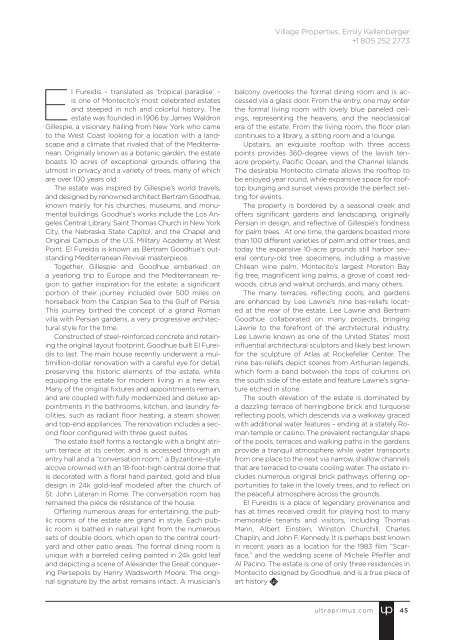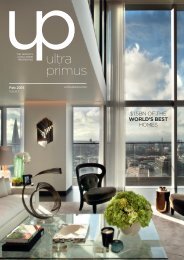$1.5BN OF THE WORLD’S BEST HOMES
Create successful ePaper yourself
Turn your PDF publications into a flip-book with our unique Google optimized e-Paper software.
Village Properties, Emily Kellenberger<br />
+1 805 252 2773<br />
El Fureidis – translated as ‘tropical paradise’ –<br />
is one of Montecito’s most celebrated estates<br />
and steeped in rich and colorful history. The<br />
estate was founded in 1906 by James Waldron<br />
Gillespie, a visionary hailing from New York who came<br />
to the West Coast looking for a location with a landscape<br />
and a climate that rivaled that of the Mediterranean.<br />
Originally known as a botanic garden, the estate<br />
boasts 10 acres of exceptional grounds offering the<br />
utmost in privacy and a variety of trees, many of which<br />
are over 100 years old.<br />
The estate was inspired by Gillespie’s world travels,<br />
and designed by renowned architect Bertram Goodhue,<br />
known mainly for his churches, museums, and monumental<br />
buildings. Goodhue’s works include the Los Angeles<br />
Central Library, Saint Thomas Church in New York<br />
City, the Nebraska State Capitol, and the Chapel and<br />
Original Campus of the U.S. Military Academy at West<br />
Point. El Fureidis is known as Bertram Goodhue’s outstanding<br />
Mediterranean Revival masterpiece.<br />
Together, Gillespie and Goodhue embarked on<br />
a yearlong trip to Europe and the Mediterranean region<br />
to gather inspiration for the estate; a significant<br />
portion of their journey included over 500 miles on<br />
horseback from the Caspian Sea to the Gulf of Persia.<br />
This journey birthed the concept of a grand Roman<br />
villa with Persian gardens, a very progressive architectural<br />
style for the time.<br />
Constructed of steel-reinforced concrete and retaining<br />
the original layout footprint, Goodhue built El Fureidis<br />
to last. The main house recently underwent a multimillion-dollar<br />
renovation with a careful eye for detail,<br />
preserving the historic elements of the estate, while<br />
equipping the estate for modern living in a new era.<br />
Many of the original fixtures and appointments remain,<br />
and are coupled with fully modernized and deluxe appointments<br />
in the bathrooms, kitchen, and laundry facilities,<br />
such as radiant floor heating, a steam shower,<br />
and top-end appliances. The renovation includes a second<br />
floor configured with three guest suites.<br />
The estate itself forms a rectangle with a bright atrium<br />
terrace at its center, and is accessed through an<br />
entry hall and a “conversation room,” a Byzantine-style<br />
alcove crowned with an 18-foot-high central dome that<br />
is decorated with a floral hand painted, gold and blue<br />
design in 24k gold-leaf modeled after the church of<br />
St. John Lateran in Rome. The conversation room has<br />
remained the piéce de résistance of the house.<br />
Offering numerous areas for entertaining, the public<br />
rooms of the estate are grand in style. Each public<br />
room is bathed in natural light from the numerous<br />
sets of double doors, which open to the central courtyard<br />
and other patio areas. The formal dining room is<br />
unique with a barreled ceiling painted in 24k gold leaf<br />
and depicting a scene of Alexander the Great conquering<br />
Persepolis by Henry Wadsworth Moore. The original<br />
signature by the artist remains intact. A musician’s<br />
balcony overlooks the formal dining room and is accessed<br />
via a glass door. From the entry, one may enter<br />
the formal living room with lovely blue paneled ceilings,<br />
representing the heavens, and the neoclassical<br />
era of the estate. From the living room, the floor plan<br />
continues to a library, a sitting room and a lounge.<br />
Upstairs, an exquisite rooftop with three access<br />
points provides 360-degree views of the lavish tenacre<br />
property, Pacific Ocean, and the Channel Islands.<br />
The desirable Montecito climate allows the rooftop to<br />
be enjoyed year round, while expansive space for rooftop<br />
lounging and sunset views provide the perfect setting<br />
for events.<br />
The property is bordered by a seasonal creek and<br />
offers significant gardens and landscaping, originally<br />
Persian in design, and reflective of Gillespie’s fondness<br />
for palm trees. At one time, the gardens boasted more<br />
than 100 different varieties of palm and other trees, and<br />
today the expansive 10-acre grounds still harbor several<br />
century-old tree specimens, including a massive<br />
Chilean wine palm, Montecito’s largest Moreton Bay<br />
fig tree, magnificent king palms, a grove of coast redwoods,<br />
citrus and walnut orchards, and many others.<br />
The many terraces, reflecting pools, and gardens<br />
are enhanced by Lee Lawrie’s nine bas-reliefs located<br />
at the rear of the estate. Lee Lawrie and Bertram<br />
Goodhue collaborated on many projects, bringing<br />
Lawrie to the forefront of the architectural industry.<br />
Lee Lawrie known as one of the United States’ most<br />
influential architectural sculptors and likely best known<br />
for the sculpture of Atlas at Rockefeller Center. The<br />
nine bas-reliefs depict scenes from Arthurian legends,<br />
which form a band between the tops of columns on<br />
the south side of the estate and feature Lawrie’s signature<br />
etched in stone.<br />
The south elevation of the estate is dominated by<br />
a dazzling terrace of herringbone brick and turquoise<br />
reflecting pools, which descends via a walkway graced<br />
with additional water features – ending at a stately Roman<br />
temple or casino. The prevalent rectangular shape<br />
of the pools, terraces and walking paths in the gardens<br />
provide a tranquil atmosphere while water transports<br />
from one place to the next via narrow, shallow channels<br />
that are terraced to create cooling water. The estate includes<br />
numerous original brick pathways offering opportunities<br />
to take in the lovely trees, and to reflect on<br />
the peaceful atmosphere across the grounds.<br />
El Fureidis is a place of legendary provenance and<br />
has at times received credit for playing host to many<br />
memorable tenants and visitors, including Thomas<br />
Mann, Albert Einstein, Winston Churchill, Charles<br />
Chaplin, and John F. Kennedy. It is perhaps best known<br />
in recent years as a location for the 1983 film “Scarface,”<br />
and the wedding scene of Michele Pfeiffer and<br />
Al Pacino. The estate is one of only three residences in<br />
Montecito designed by Goodhue, and is a true piece of<br />
art history<br />
ultraprimus.com<br />
45



